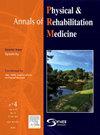呼吸康复对covid -19后症状患者生活质量的影响:一项随机对照试验
IF 3.9
3区 医学
Q1 REHABILITATION
Annals of Physical and Rehabilitation Medicine
Pub Date : 2025-02-01
DOI:10.1016/j.rehab.2024.101920
引用次数: 0
摘要
背景:吸气和呼气肌训练(RMT)已被证明对长期出现covid -19后症状的个体有益。目的:评估在有氧运动(AE)训练计划中加入RMT对covid -19后长期症状患者健康相关生活质量(HRQoL)和运动耐量的影响,并评估其对身体和肺功能以及心理状态的影响。方法:将64例长期出现covid -19后疲劳和呼吸困难症状的患者随机分为AE+RMT组或AE+RMTsham组,进行8周的干预(AE: 50分钟/天,2次/周;RMT: 40分钟/天,3次/周)主要结局为HRQoL (EuroQol-5D问卷)和运动耐量(心肺运动试验)。次要结局是身体功能:呼吸肌功能(吸气/呼气肌力量和吸气肌耐力)、下肢和上肢力量(1分钟坐立和握力);肺功能:肺活量测定和肺弥散能力;以及心理状态(焦虑/抑郁水平)。结果:干预后,与AE+RMTsham组相比,AE+RMT组HRQoL和运动耐量无统计学意义的改善。与AE+RMTsham组相比,AE+RMT组呼吸肌功能有较大改善(d = 0.7 ~ 1.3),呼气峰流量有中低改善(d = 0.4)。AE+RMT组肺功能结局、下肢和上肢力量和心理状态的增加并不比AE+RMTsham组多。结论:对于长期出现covid -19后症状的个体,将RMT与AE训练计划相结合可改善呼吸肌力量、吸气肌耐力和呼气峰值流量;然而,在HRQoL、运动耐量、心理困扰和肺弥散能力方面,组间差异无统计学意义。数据库注册:美国临床试验注册中心(NCT05597774)。本文章由计算机程序翻译,如有差异,请以英文原文为准。
Effect of respiratory rehabilitation on quality of life in individuals with post-COVID-19 symptoms: A randomised controlled trial
Background
Inspiratory and expiratory muscle training (RMT) has been shown to have beneficial effects in individuals with long-term post-COVID-19 symptoms.
Objective
To assess the effects of adding RMT to an aerobic exercise (AE) training program for health-related quality of life (HRQoL) and exercise tolerance in individuals with long-term post-COVID-19 symptoms, and to evaluate the effects on physical and lung function, and psychological status.
Methods
64 individuals with long-term post-COVID-19 symptoms of fatigue and dyspnoea were randomly assigned to AE+RMT or AE+RMTsham groups for an 8-wk intervention (AE: 50min/day, 2 times/wk; RMT: 40min/day, 3 times/wk). Primary outcomes were HRQoL (EuroQol-5D questionnaire) and exercise tolerance (cardiopulmonary exercise test). Secondary outcomes were physical function: respiratory muscle function (inspiratory/expiratory muscle strength and inspiratory muscle endurance), lower and upper limb strength (1-min Sit-to-Stand and handgrip force); lung function: spirometry testing and lung diffusing capacity; and psychological status (anxiety/depressive levels).
Results
Postintervention, there were no statistically significant improvements in HRQoL or exercise tolerance in the AE+RMT compared with the AE+RMTsham group. In the AE+RMT group, large improvements in respiratory muscle function (d = 0.7 to 1.3) and low-moderate improvements in peak expiratory flow (d = 0.4) occurred compared with the AE+RMTsham group. Lung function outcomes, lower and upper limb strength and psychological status did not increase more in the AE+RMT group than in the AE+RMTsham group.
Conclusion
For individuals with long-term post-COVID-19 symptoms, combining RMT with an AE training program resulted in improvements in respiratory muscle strength, inspiratory muscle endurance and peak expiratory flow; however, the differences between groups were not statistically significant for HRQoL, exercise tolerance, psychological distress, and lung diffusing capacity.
Database registration
United States Clinical Trials Registry (NCT05597774)
求助全文
通过发布文献求助,成功后即可免费获取论文全文。
去求助
来源期刊

Annals of Physical and Rehabilitation Medicine
Medicine-Rehabilitation
CiteScore
7.80
自引率
4.30%
发文量
136
审稿时长
34 days
期刊介绍:
Annals of Physical and Rehabilitation Medicine covers all areas of Rehabilitation and Physical Medicine; such as: methods of evaluation of motor, sensory, cognitive and visceral impairments; acute and chronic musculoskeletal disorders and pain; disabilities in adult and children ; processes of rehabilitation in orthopaedic, rhumatological, neurological, cardiovascular, pulmonary and urological diseases.
 求助内容:
求助内容: 应助结果提醒方式:
应助结果提醒方式:


